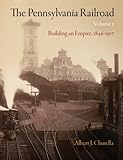The Pennsylvania Railroad, Volume 1 : Building an Empire, 1846-1917 / Albert J. Churella.
Material type: TextSeries: American Business, Politics, and SocietyPublisher: Philadelphia : University of Pennsylvania Press, [2012]Copyright date: ©2012Description: 1 online resource (968 p.) : 92 illusContent type:
TextSeries: American Business, Politics, and SocietyPublisher: Philadelphia : University of Pennsylvania Press, [2012]Copyright date: ©2012Description: 1 online resource (968 p.) : 92 illusContent type: - 9780812243482
- 9780812207620
- 385.09748 23
- HE2791.P43 C48 2013eb
- online - DeGruyter
- Issued also in print.
| Item type | Current library | Call number | URL | Status | Notes | Barcode | |
|---|---|---|---|---|---|---|---|
 eBook
eBook
|
Biblioteca "Angelicum" Pont. Univ. S.Tommaso d'Aquino Nuvola online | online - DeGruyter (Browse shelf(Opens below)) | Online access | Not for loan (Accesso limitato) | Accesso per gli utenti autorizzati / Access for authorized users | (dgr)9780812207620 |
Frontmatter -- Contents -- Introduction -- Abbreviations -- Chapter 1. The Way West 1682-1826 -- Chapter 2. Commonwealth 1826-1846 -- Chapter 3. Community 1846 -- Chapter 4. Enterprise, 1846-1852 -- Chapter 5. Executive, 1852-1857 -- Chapter 6. Coordination, 1857-1860 -- Chapter 7. Expansion, 1850-1868 -- Chapter 8. Conflict 1860-1868 -- Chapter 9. Empire, 1868-1876 -- Chapter 10. Connections, 1865-1873 -- Chapter 11. Limits, 1874-1877 -- Chapter 12. Order, 1877-1899 -- Chapter 13. System, 1889-1929 -- Chapter 14. Regulation, 1899-1910 -- Chapter 15. Terminus, 1917 -- Notes -- Index -- Acknowledgments
restricted access online access with authorization star
http://purl.org/coar/access_right/c_16ec
"Do not think of the Pennsylvania Railroad as a business enterprise," Forbes magazine informed its readers in May 1936. "Think of it as a nation." At the end of the nineteenth century, the Pennsylvania Railroad was the largest privately owned business corporation in the world. In 1914, the PRR employed more than two hundred thousand people-more than double the number of soldiers in the United States Army. As the self-proclaimed "Standard Railroad of the World," this colossal corporate body underwrote American industrial expansion and shaped the economic, political, and social environment of the United States. In turn, the PRR was fundamentally shaped by the American landscape, adapting to geography as well as shifts in competitive economics and public policy. Albert J. Churella's masterful account, certain to become the authoritative history of the Pennsylvania Railroad, illuminates broad themes in American history, from the development of managerial practices and labor relations to the relationship between business and government to advances in technology and transportation.Churella situates exhaustive archival research on the Pennsylvania Railroad within the social, economic, and technological changes of nineteenth- and twentieth-century America, chronicling the epic history of the PRR intertwined with that of a developing nation. This first volume opens with the development of the Main Line of Public Works, devised by Pennsylvanians in the 1820s to compete with the Erie Canal. Though a public rather than a private enterprise, the Main Line foreshadowed the establishment of the Pennsylvania Railroad in 1846. Over the next decades, as the nation weathered the Civil War, industrial expansion, and labor unrest, the PRR expanded despite competition with rival railroads and disputes with such figures as Andrew Carnegie and John D. Rockefeller. The dawn of the twentieth century brought a measure of stability to the railroad industry, enabling the creation of such architectural monuments as Pennsylvania Station in New York City. The volume closes at the threshold of American involvement in World War I, as the strategies that PRR executives had perfected in previous decades proved less effective at guiding the company through increasingly tumultuous economic and political waters.
Issued also in print.
Mode of access: Internet via World Wide Web.
In English.
Description based on online resource; title from PDF title page (publisher's Web site, viewed 24. Apr 2022)


